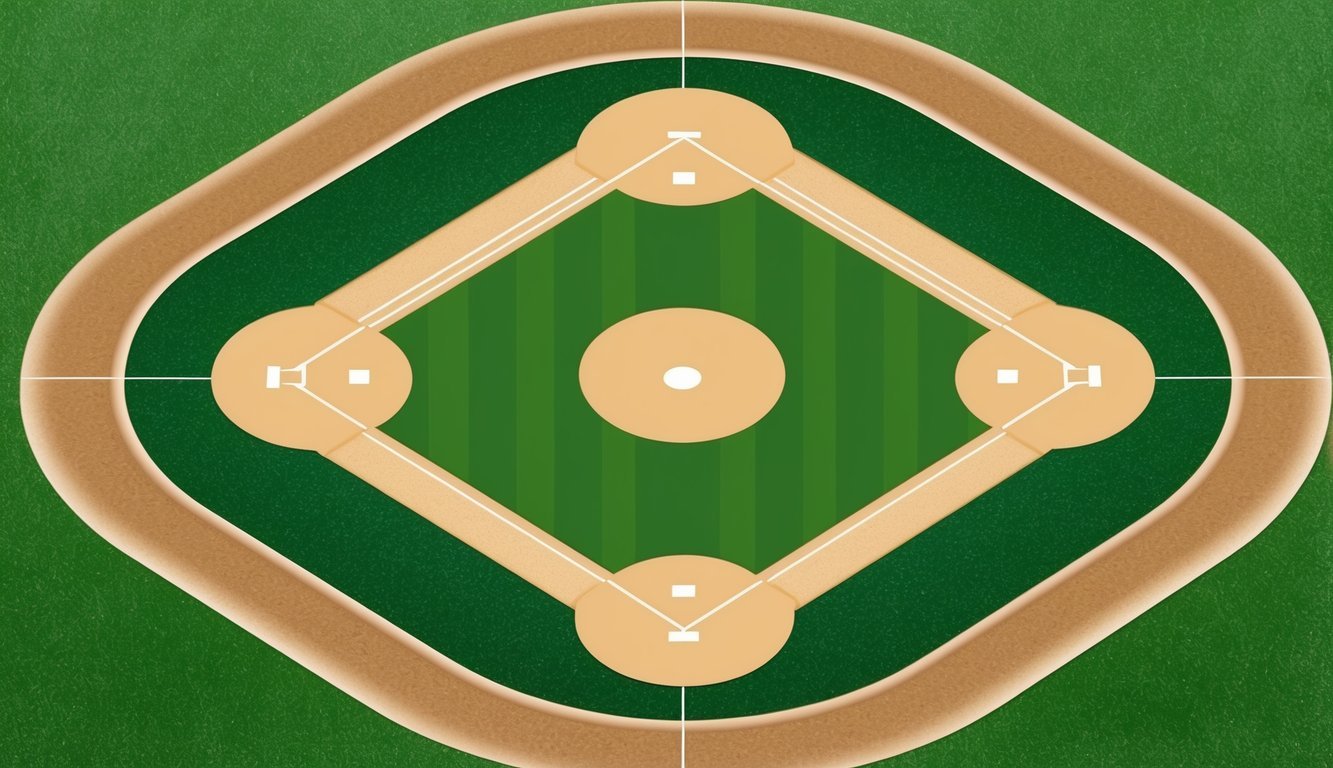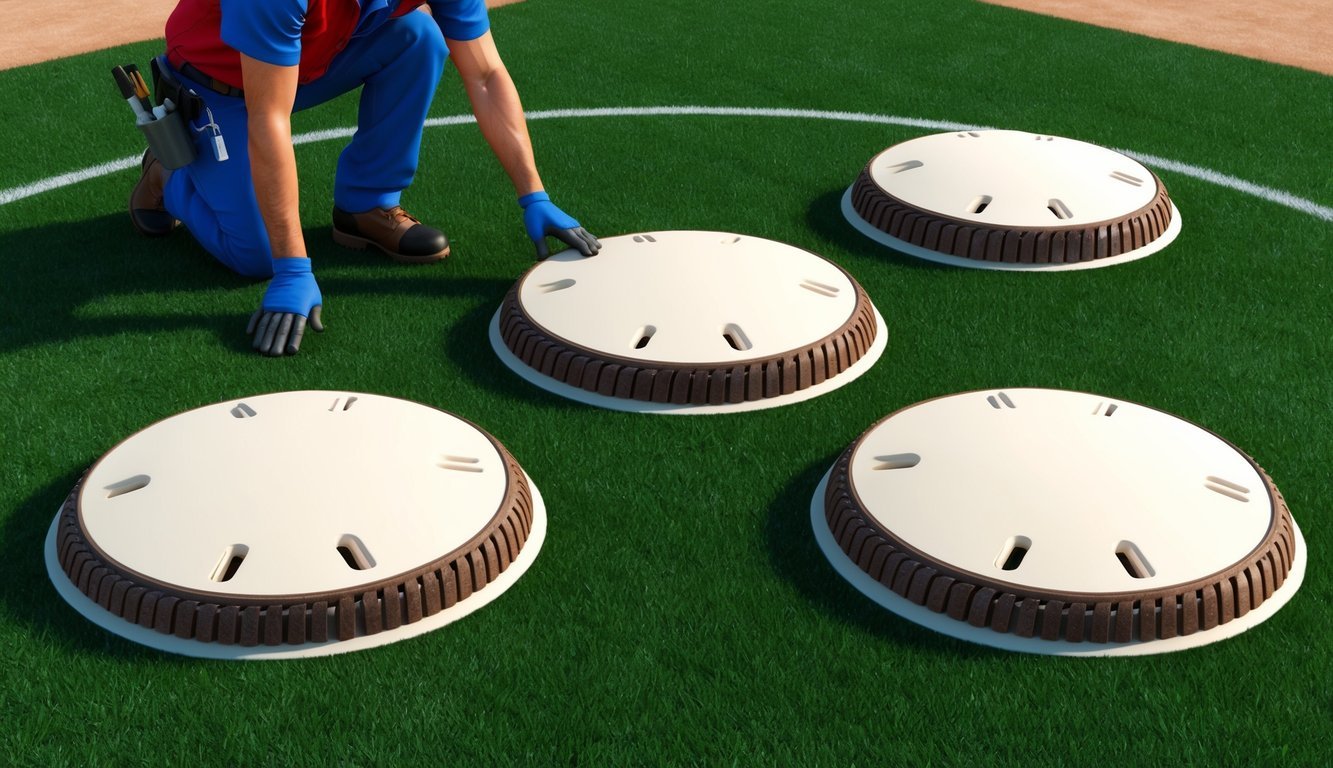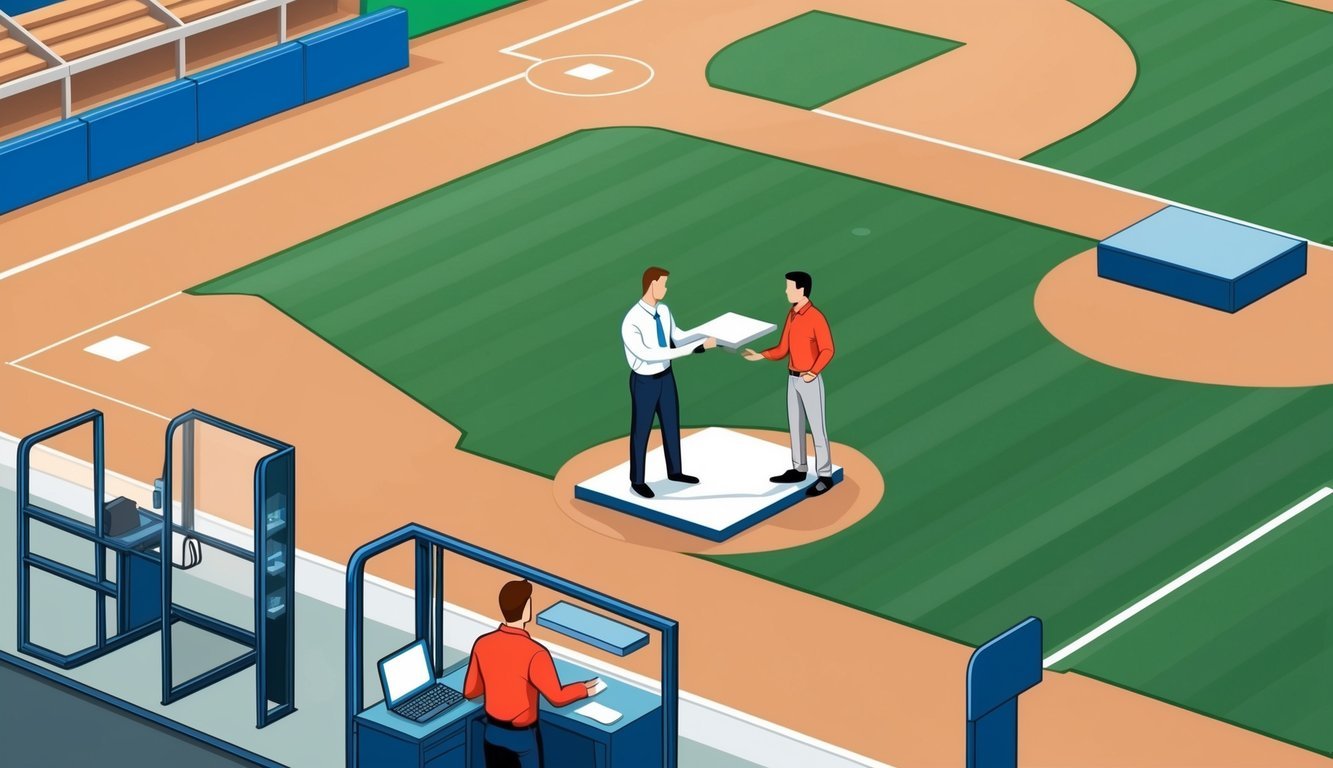Baseball bases are an essential part of America’s favorite pastime.
These simple white squares mark the path players must run to score, forming the diamond shape iconic to baseball fields everywhere.
A standard baseball base set includes three bases, home plate, and a pitcher’s rubber. These can be made of various materials, from heavy-duty rubber for durability to softer foam for safety in youth leagues.
Some bases are designed to break away when a player slides into them, reducing the risk of injury.
Baseball bases aren’t just for the big leagues.
Many families and recreational players enjoy setting up backyard games with portable base sets.
These often come in bright colors and can be used for baseball, softball, or even kickball.
Whether for professional play or casual fun, baseball bases help bring the excitement of the ballpark home.
History and Evolution of Baseball Bases
Baseball bases have undergone significant changes since the sport’s early days.
Their size, shape, and positioning have evolved to enhance gameplay and player safety.
Early Beginnings
In the mid-19th century, baseball bases were quite different from today’s standards.
They varied in size and material, often made from wood or stone.
The home plate started as a circular object before evolving into its current pentagonal shape.
First and third bases were initially positioned with one side parallel to home plate.
Second base was turned so a corner faced home.
This unique arrangement created challenges for players and umpires alike.
Base dimensions changed over time.
In 1857, bases measured 12 inches square.
By the 1870s, they grew to 15 inches square, providing a larger target for baserunners.
Professional Development
As baseball became more organized, so did the rules governing bases.
In 1877, home plate was moved entirely into fair territory, simplifying umpires’ decisions on foul balls.
The iconic 90-foot distance between bases wasn’t always the standard.
Early fields varied in size, with bases sometimes placed at different intervals.
The current 90-foot measurement was gradually adopted as the game developed.
Modern bases are designed for player safety.
They’re made of rubber or similar materials, often with a “breakaway” feature to reduce injury risk during slides.
This evolution reflects baseball’s ongoing commitment to improving gameplay while protecting its athletes.
Types of Baseball Bases
Baseball bases come in several varieties, each designed for different purposes and levels of play.
The main types include anchored, breakaway, throw-down, and magnetic bases.
Each offers unique features to enhance player safety and game performance.
Anchored Bases
Anchored bases are firmly secured to the ground, providing a stable foundation for players.
These bases use a metal anchor system buried beneath the field’s surface.
The base itself attaches to this anchor with a sturdy post or stem.
Anchored bases are common in professional and higher-level amateur leagues.
They offer excellent stability for runners and fielders alike.
The solid connection to the ground prevents the base from shifting during play.
One drawback is the potential for player injuries during slides.
The rigid nature of anchored bases can lead to more impact-related issues.
However, they remain popular due to their durability and consistent positioning.
Breakaway Bases
Breakaway bases represent a significant advancement in player safety.
These bases detach from their anchor upon impact, reducing the risk of injuries during slides.
The design features a base that sits on top of a rubber mat or grommets.
When a player slides into the base with force, it separates from its foundation.
This action disperses the energy of the collision, lowering the chance of sprains, fractures, or other sliding-related injuries.
Many youth leagues and professional organizations have adopted breakaway bases.
The Rogers Break Away Base is a popular example, used widely from little leagues to MLB training camps.
Breakaway bases combine safety with practicality.
They’re easy to reattach after dislodging and maintain their position during normal gameplay.
Throw-Down Bases
Throw-down bases are portable and require no installation.
They’re simply placed on the field before play and removed afterward.
These bases are ideal for casual games, practice sessions, or temporary fields.
Made from durable rubber or similar materials, throw-down bases often feature a weighted design to help them stay in place.
Some models include cleats or spikes on the bottom for added stability.
Their portability makes throw-down bases popular for youth leagues, school programs, and recreational play.
They’re also useful for indoor practice facilities where permanent base installations aren’t feasible.
While convenient, throw-down bases may shift during intense gameplay.
They’re best suited for lower-impact situations or as training aids.
Magnetic Bases
Magnetic bases offer a blend of stability and safety.
These bases use strong magnets to attach to metal plates buried in the ground.
The magnetic connection allows the base to stay firmly in place during normal play but detach when a player slides with significant force.
This design provides a middle ground between anchored and breakaway bases.
Magnetic bases resist movement during routine plays but can separate to reduce injury risk during aggressive slides.
Installation of magnetic bases requires more initial setup than throw-down options.
However, once installed, they offer a reliable and potentially safer alternative to traditional anchored bases.
Baseball Field Layout

A properly laid out baseball field is crucial for fair and safe gameplay.
The diamond shape and precise measurements ensure consistency across different levels of play.
Base and Plate Specifications
Home plate forms the focal point of the baseball diamond.
It’s a five-sided slab of whitened rubber, 17 inches wide at the front edge.
The other bases are 15-inch squares, typically made of canvas or rubber, anchored securely to the ground.
Surrounding home plate, players rely on various home plate equipment essentials to ensure a fair game.
This includes the strike zone markers and the home plate itself, which must always be kept in good condition to facilitate accurate calls by the umpire.
Additionally, the area surrounding home plate is often marked to help guide players during crucial moments of the game, making it a busy hub of activity on the field.
The distance between bases is 90 feet in professional baseball.
Youth leagues often use shorter base paths, ranging from 50 to 80 feet depending on age group.
Bases should be positioned so their outer edges align with the foul lines.
On artificial turf fields, bases are sometimes painted on or embedded in the surface.
This can reduce maintenance but may affect sliding techniques.
Pitching Rubbers and Placement
The pitching rubber is a rectangular slab of whitened rubber, 24 inches long and 6 inches wide.
Its placement is critical to the game’s balance between offense and defense.
In MLB, the front edge of the pitching rubber is 60 feet 6 inches from the back point of home plate.
Youth leagues use shorter distances, typically ranging from 40 to 54 feet.
The rubber should be level with the ground and oriented so its long edges face the batter.
A well-maintained mound slopes gradually up to the rubber, giving pitchers proper footing for their delivery.
Safety and Maintenance

Proper safety measures and regular maintenance are crucial for creating a secure and enjoyable baseball experience.
These practices help protect players from injuries and ensure the field remains in top condition.
Player Safety Considerations
Baseball bases play a key role in player safety.
Breakaway bases have become popular, as they’re designed to dislodge upon impact, reducing the risk of injuries during slides.
These bases absorb energy from collisions, making them safer than traditional fixed bases.
Protective equipment is also essential.
Helmets shield batters and base runners from potential head injuries.
Catchers require additional gear, including masks, chest protectors, and shin guards.
Safety nets around the field protect spectators from foul balls and errant throws.
Some leagues have extended netting further down the foul lines to enhance crowd safety.
Proper field maintenance also contributes to player safety.
Ensuring a smooth, even playing surface helps prevent trips and falls.
Maintenance of Bases and Grounds
Regular upkeep of bases is vital for both safety and gameplay quality.
Inspect bases before each game for signs of wear or damage.
Replace worn-out bases promptly to maintain optimal performance and safety.
Clean bases regularly to remove dirt and debris.
This helps maintain their grip and prevents slipping.
For breakaway bases, check the release mechanisms to ensure they function correctly.
Field maintenance is equally important.
Keep the infield dirt smooth and level.
Fill in any holes or depressions that could cause players to stumble.
Water the infield to prevent dust and maintain proper playing conditions.
Outfield grass should be mowed regularly and at the appropriate height.
Check for and remove any debris or foreign objects from the field.
Proper drainage is crucial to prevent water accumulation and ensure playability after rain.
Purchasing and Customer Support

Selecting the right baseball bases and accessing quality customer support are crucial for players and field managers.
Professional-grade equipment and responsive service enhance safety and satisfaction.
Selecting the Right Equipment
When choosing baseball bases, consider the level of play and field conditions.
Professional leagues often require specific base types that meet safety standards.
Youth leagues may have different requirements.
Look for bases with features like:
- Break-away design for player safety
- Durable materials that withstand weather and frequent use
- Easy installation and removal
Some manufacturers offer bases tailored for indoor or outdoor use.
Check product specifications to ensure compatibility with your field setup.
Ensuring Quality and Durability
High-quality bases are an investment in player safety and field longevity.
Look for products with warranties, which can indicate the manufacturer’s confidence in their durability.
Key factors to consider:
- Material strength
- Weather resistance
- Compliance with league regulations
Many reputable companies offer bases that meet or exceed Little League safety standards.
These often feature disengage-able designs to reduce sliding injuries.
Proper maintenance can extend the life of your bases.
Follow manufacturer guidelines for cleaning and storage to preserve their quality.
Customer Service Excellence
Top baseball equipment providers prioritize customer satisfaction.
They often offer:
- Knowledgeable staff to answer product questions
- Assistance with selecting appropriate equipment
- Support for installation and maintenance
Look for companies with dedicated customer service lines.
Some offer 24/7 support, which can be crucial during tournament seasons.
Many providers have online resources like product guides and FAQs.
These can help with quick troubleshooting and maintenance tips.
When purchasing bats or other equipment, seek out sellers who offer personalized service.
They can guide you to the best products for your specific needs and playing style.
